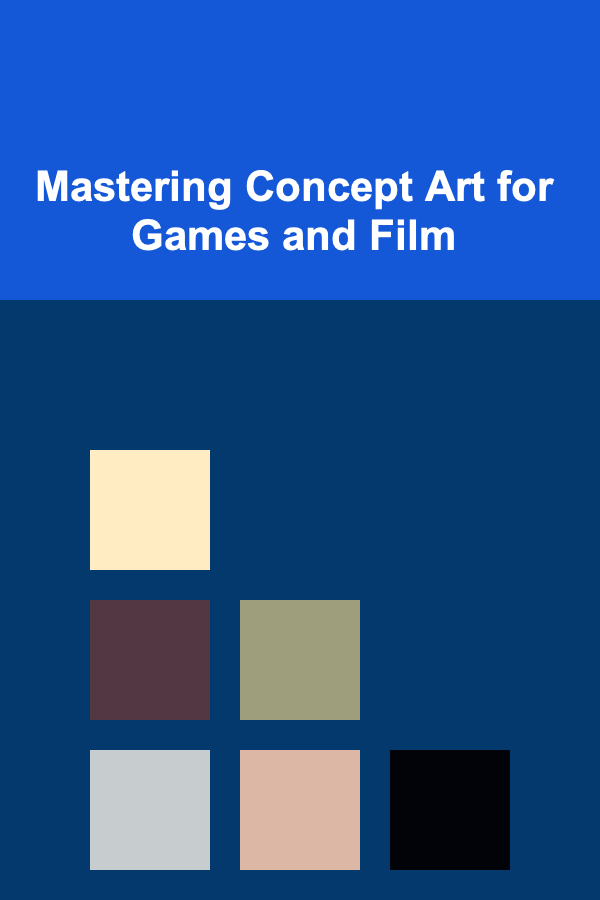
Mastering Concept Art for Games and Film
ebook include PDF & Audio bundle (Micro Guide)
$12.99$5.99
Limited Time Offer! Order within the next:

Concept art is the visual embodiment of ideas, the bridge between imagination and realization in the worlds of games and film. It's more than just pretty pictures; it's a crucial element in the pre-production phase, shaping the overall aesthetic, atmosphere, and narrative direction of a project. Mastering concept art requires a unique blend of artistic skill, technical proficiency, and a deep understanding of the creative process involved in these industries. This article will delve into the essential aspects of concept art for games and film, providing a comprehensive guide to help aspiring artists develop their skills and break into this exciting field.
Understanding the Role of a Concept Artist
Before diving into the specifics of artistic techniques, it's crucial to understand the multifaceted role of a concept artist. They are not simply illustrators, but rather visual problem-solvers, tasked with translating abstract ideas into tangible visuals. Their responsibilities often include:
- Visualizing Ideas: Taking written descriptions, vague concepts, or initial briefs and translating them into visual representations. This requires strong interpretative skills and the ability to extrapolate details from limited information.
- World-Building: Creating cohesive and believable worlds, including environments, characters, props, and vehicles. This involves considering factors like history, culture, technology, and geography.
- Character Design: Developing characters that are not only visually appealing but also convey personality, background, and role within the story. This involves exploring different silhouettes, costumes, and facial expressions.
- Environment Design: Creating compelling and immersive environments that support the narrative and evoke specific emotions. This includes considering lighting, composition, and atmospheric perspective.
- Prop and Vehicle Design: Designing functional and visually interesting props and vehicles that fit the world and serve a purpose within the story. This requires an understanding of mechanics, ergonomics, and aesthetics.
- Mood and Atmosphere: Communicating the desired mood and atmosphere of a scene or environment through the use of color, lighting, and composition.
- Collaboration: Working closely with art directors, game designers, filmmakers, and other members of the creative team to ensure that the visual direction aligns with the overall vision.
- Problem Solving: Finding creative solutions to design challenges, such as making a character visually distinct or creating a believable alien landscape.
- Iteration and Refinement: Creating multiple iterations of designs and refining them based on feedback from the creative team. This requires a willingness to experiment and adapt.
In essence, a concept artist is a visual communicator, using their skills to convey ideas and solve problems in a creative and efficient manner. They are an integral part of the pre-production process, helping to shape the visual identity of a game or film.
Essential Skills for Concept Art
To excel as a concept artist, a strong foundation in fundamental art skills is essential. These skills provide the building blocks for creating compelling and believable visuals.
Fundamental Art Skills:
- Anatomy: A thorough understanding of human and animal anatomy is crucial for creating believable characters and creatures. This includes studying bone structure, muscle groups, and proportions. Don't just memorize; learn to apply anatomical knowledge to dynamic poses and diverse body types.
- Perspective: Mastering perspective is essential for creating realistic and immersive environments. This includes understanding one-point, two-point, and three-point perspective, as well as atmospheric perspective. Practice drawing environments from different viewpoints.
- Composition: Composition refers to the arrangement of elements within an image. A strong composition guides the viewer's eye and creates a sense of balance and harmony. Learn about rules like the rule of thirds, leading lines, and framing.
- Color Theory: Understanding color theory is essential for creating visually appealing and emotionally resonant images. This includes understanding color relationships, color palettes, and the psychology of color. Experiment with different color schemes to evoke different moods.
- Light and Shadow: The way light and shadow interact with surfaces is crucial for creating depth, form, and realism. Study how light behaves in different environments and how it affects the appearance of different materials.
- Value: Value refers to the lightness or darkness of a color. A strong understanding of value is essential for creating depth, contrast, and form. Practice creating value studies to improve your ability to see and render values accurately.
- Form and Volume: Understanding how to represent three-dimensional forms on a two-dimensional surface is critical. Practice rendering basic shapes (spheres, cubes, cylinders) and gradually progress to more complex forms.
- Gesture Drawing: Capturing the essence of a pose or action quickly and expressively. This is vital for dynamic character design and conveying movement.
Technical Proficiency:
While traditional art skills are essential, modern concept art also requires proficiency in digital tools. Mastering these tools will significantly enhance your workflow and allow you to explore a wider range of techniques.
- Digital Painting Software: Programs like Adobe Photoshop, Procreate (for iPad), and Clip Studio Paint are industry standards. Proficiency in these programs includes understanding layers, brushes, blending modes, and various painting techniques.
- 3D Modeling Software: While not always required, knowledge of 3D modeling software like Blender (free and open-source), ZBrush, or Maya can be beneficial for creating complex shapes and environments. 3D software can be used to create base models that can then be painted over in 2D.
- Digital Sculpting: ZBrush is a powerful tool for creating highly detailed character and creature designs. Learning the basics of digital sculpting allows for more organic and nuanced forms.
- Photo Manipulation: The ability to seamlessly integrate and manipulate photographs is crucial for creating realistic environments and adding detail to concepts.
- AI Tools: The rapid advancements in AI image generation tools (Midjourney, Stable Diffusion, DALL-E 2) are changing the landscape of concept art. While AI cannot replace human creativity, it can be used as a powerful tool for generating ideas, exploring different variations, and creating mood boards. Understanding how to effectively prompt and refine AI-generated images is becoming an increasingly valuable skill.
Soft Skills:
Beyond technical skills, certain soft skills are crucial for success in the collaborative environment of game and film development.
- Communication: The ability to clearly and effectively communicate your ideas to other members of the team is essential. This includes both verbal and visual communication.
- Collaboration: Concept art is rarely a solitary endeavor. You'll need to be able to work effectively with other artists, designers, and directors.
- Adaptability: Projects can change rapidly, and you'll need to be able to adapt to new requirements and feedback.
- Problem-Solving: Concept art is often about solving visual problems. You'll need to be able to think creatively and find innovative solutions.
- Time Management: Meeting deadlines is crucial in the fast-paced world of game and film development. You'll need to be able to manage your time effectively and prioritize tasks.
- Receiving Feedback: Being able to accept and learn from criticism is essential for growth as an artist. Don't take feedback personally; see it as an opportunity to improve your work.
Developing Your Concept Art Portfolio
Your portfolio is your most important tool for showcasing your skills and landing a job in the industry. It should be carefully curated to highlight your best work and demonstrate your ability to create concept art for games and film.
Portfolio Content:
- Focus on Relevance: Tailor your portfolio to the specific type of concept art you're interested in. If you want to work on character design, showcase your best character designs. If you want to work on environment design, showcase your best environment designs.
- Showcase Variety: While focusing on a specific area is important, it's also beneficial to showcase some variety in your skills. This demonstrates your versatility and ability to adapt to different styles and projects.
- Include Finished Pieces and Works in Progress: Finished pieces demonstrate your ability to see a project through to completion, while works in progress can showcase your process and problem-solving skills.
- Add Context: Don't just show the final image; provide context about the project, the brief you were given, and the challenges you faced. This helps demonstrate your understanding of the role of a concept artist.
- Quality over Quantity: It's better to have a small portfolio of high-quality work than a large portfolio of mediocre work. Focus on showcasing your best pieces.
- Update Regularly: Keep your portfolio up-to-date with your latest and greatest work. This shows that you're actively improving your skills and staying relevant in the industry.
Portfolio Presentation:
- Online Portfolio: Create an online portfolio website using platforms like ArtStation, Behance, or your own custom website.
- Clear and Concise: Make sure your portfolio is easy to navigate and visually appealing. Use high-resolution images and clear descriptions.
- Mobile-Friendly: Ensure your portfolio is responsive and looks good on all devices, including smartphones and tablets.
- Professional Presentation: Pay attention to the overall presentation of your portfolio. This includes the design of your website, the quality of your images, and the clarity of your descriptions.
- Get Feedback: Ask other artists, mentors, or recruiters to review your portfolio and provide feedback.
Breaking into the Industry
Getting your foot in the door as a concept artist can be challenging, but with hard work, dedication, and a strategic approach, it's definitely achievable.
Networking:
- Attend Industry Events: Attend industry events like GDC (Game Developers Conference), SIGGRAPH, or Comic-Con to network with other artists, designers, and recruiters.
- Online Communities: Join online communities like ArtStation, DeviantArt, and ConceptArt.org to connect with other artists, share your work, and get feedback.
- Social Media: Use social media platforms like LinkedIn, Twitter, and Instagram to connect with industry professionals and showcase your work.
Job Search Strategies:
- Target Your Applications: Tailor your resume and cover letter to each specific job application. Highlight your skills and experience that are most relevant to the position.
- Research Companies: Before applying to a company, research their work and culture. This will help you tailor your application and demonstrate your genuine interest in working for them.
- Internships: Internships are a great way to gain experience and make connections in the industry.
- Freelance Work: Freelance work can be a good way to build your portfolio and gain experience while searching for a full-time position.
- Online Job Boards: Regularly check online job boards like LinkedIn, Indeed, and Glassdoor for concept art positions.
- Personal Projects: Working on personal projects can be a great way to improve your skills and build your portfolio. Choose projects that are relevant to the type of concept art you're interested in.
Continuous Learning:
- Stay Up-to-Date: The field of concept art is constantly evolving, so it's important to stay up-to-date with the latest trends, techniques, and technologies.
- Take Online Courses: There are many excellent online courses available that can help you improve your skills in specific areas of concept art. Platforms like Schoolism, CGMA, and LearnSquared offer high-quality instruction from industry professionals.
- Practice Regularly: The key to mastering any skill is consistent practice. Set aside time each day or week to practice your concept art skills.
- Seek Feedback: Regularly seek feedback from other artists, mentors, or recruiters. This will help you identify areas where you can improve and stay on track with your goals.
Specific Techniques for Game and Film Concept Art
While the fundamental skills are the same, there are subtle differences in the specific techniques used in concept art for games versus film. Understanding these nuances can help you tailor your approach and create more effective visuals.
Game Concept Art:
- Focus on Functionality: Game concept art often needs to consider the functionality of objects and environments within the game. This includes things like player movement, interactions, and visual clarity.
- Iterative Design: Game development is often an iterative process, so game concept art may involve creating multiple variations of designs to explore different possibilities.
- Technical Considerations: Game concept art needs to consider the technical limitations of the game engine and hardware. This can influence the level of detail and complexity of the designs.
- Consistency: Maintaining visual consistency across all elements of the game is crucial for creating a cohesive and immersive experience.
- Usability: UI (User Interface) and UX (User Experience) are extremely important. Consider how the concept art will translate to in-game usability.
Film Concept Art:
- Emphasis on Visual Storytelling: Film concept art focuses heavily on visual storytelling, conveying the mood, atmosphere, and narrative of a scene or film.
- Cinematic Composition: Film concept art often utilizes cinematic composition techniques to create visually striking and emotionally resonant images.
- Lighting and Atmosphere: The use of lighting and atmosphere is crucial in film concept art for creating a specific mood and guiding the viewer's eye.
- Realism: While stylized approaches are possible, film concept art often strives for a high degree of realism to help bring the story to life.
- Camera Angles and Framing: Consider how the scene will be filmed, including camera angles, lens choices, and framing.
The Future of Concept Art
The field of concept art is constantly evolving, driven by technological advancements and changing industry trends. As AI tools become more sophisticated and accessible, they will undoubtedly play an increasingly important role in the concept art process. However, the core skills of creativity, problem-solving, and artistic vision will remain essential for human concept artists.
The future of concept art is likely to involve a hybrid approach, where artists leverage AI tools to enhance their workflow and explore new possibilities, while still relying on their own artistic skills and experience to create truly compelling and unique visuals. The key to success in this evolving landscape will be adaptability, a willingness to embrace new technologies, and a relentless pursuit of artistic excellence.
Mastering concept art for games and film is a challenging but rewarding journey. By developing a strong foundation in fundamental art skills, embracing digital tools, and continuously learning and improving, you can build a successful career in this exciting and dynamic field.
Reading More From Our Other Websites
- [Organization Tip 101] How to Create a Family Room that Grows with Your Kids
- [Ziplining Tip 101] Best Zipline Operators in the Pacific Northwest -- Reviews & Ratings
- [Soap Making Tip 101] Navigating Regulations: Legal Essentials for Soap Makers
- [Home Budget 101] How to Manage Home and Personal Finances with Multiple Income Streams
- [Organization Tip 101] How to Prepare Your Home for Extreme Weather Conditions
- [Survival Kit 101] Survival Kit for Car: Must-Have Items for Roadside Emergencies
- [Home Cleaning 101] How to Remove Soap Scum and Hard Water Stains from Showers
- [Home Pet Care 101] How to Organize Your Home to Make It Pet-Friendly
- [Home Budget Decorating 101] How to Utilize Natural Light to Make Your Home Look More Expensive
- [Organization Tip 101] How to Choose the Right Pressure Washer for Your Siding

How to Make Money as a Travel Photographer While Exploring
Read More
How to Manage Your Time Efficiently Between Your Full-Time Job and Side Hustle
Read More
How to Optimize Your Taxes and Maximize Refunds
Read More
How to Store Your Shoes Without Taking Up Too Much Room
Read More
How to Spec Your Materials: A Guide for Industrial Designers
Read More
10 Tips for Matching Wrapping Paper to Different Occasions
Read MoreOther Products

How to Make Money as a Travel Photographer While Exploring
Read More
How to Manage Your Time Efficiently Between Your Full-Time Job and Side Hustle
Read More
How to Optimize Your Taxes and Maximize Refunds
Read More
How to Store Your Shoes Without Taking Up Too Much Room
Read More
How to Spec Your Materials: A Guide for Industrial Designers
Read More